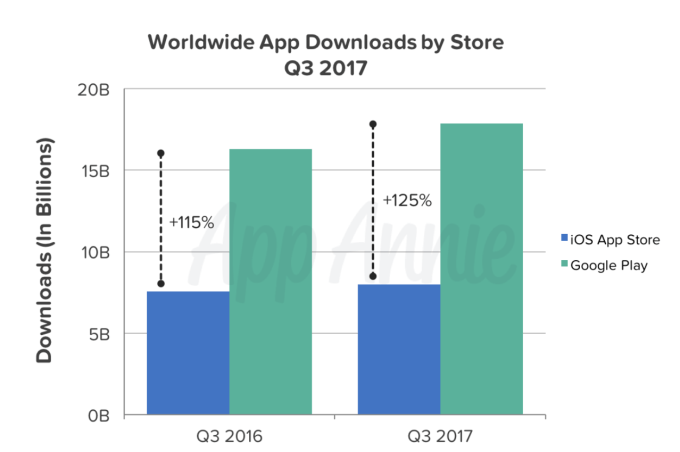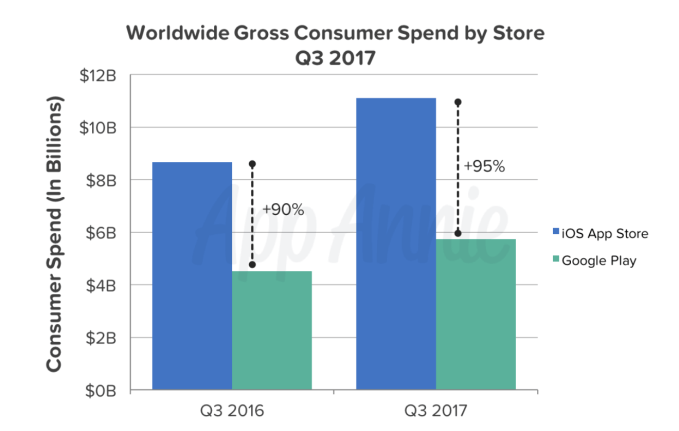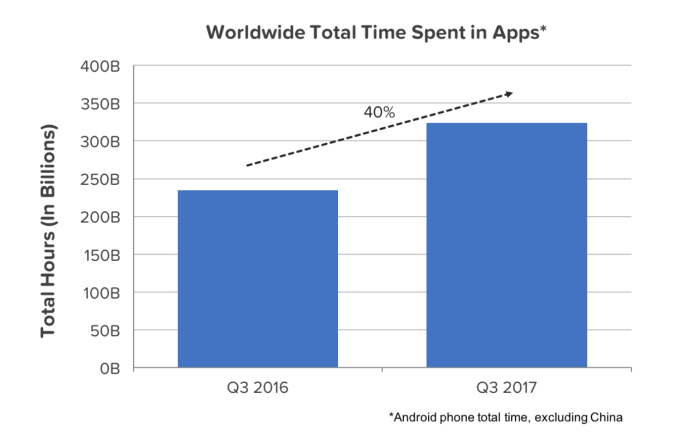|
|
|
|
|
|
|
|
App Owners are constantly chasing downloads, but to be honest, they are chasing the wrong metric. If a user doesn’t open your application in the first week, it is likely they won’t be opening your application every again. App Owners need to focus on engagement and retention as a metric to build their business. Users are only valuable if they use your application on a regular basis. What is a regular basis ? Well it depends on your application and its’ functionality, but in general users should open your application at minimum 3-5 times per week. This can be achieved with push notification, email reminders and mostly by creating an application that is fun and sticky. One that users depend and look forward to opening.
Wishing all a Happy New Year, with health and success. Thank you to our clients, suppliers, friends and family and supporters. Looking forward to 2018! 
We are very grateful to all our customers for the continued trust and support you have shown us this year. It has been a banner year for @AppPromo generating just over 1 Million app downloads for our clients. We would like to thank you by offering a complimentary 2018 App Checkup. The Checkup will review and evaluate your app’s performance in 2017 and make recommendations on growing, retaining and monetizing your audience in 2018. Look forward to helping app owners prosper in 2018!
Apple just announced new subscription features for App Developers today.
Auto-renewable subscriptions give users access to content or services from within your app on an ongoing basis. At the end of each subscription duration, the subscription will automatically renew until a user chooses to cancel it.
The revenue structure for auto-renewable subscriptions differs from other business models on the App Store. Within a subscriber’s first year of subscription, you receive 70% of the subscription price at each billing cycle, minus applicable taxes. After a subscriber accumulates one year of paid service, your revenue increases to 85% of the subscription price, minus applicable taxes.
Days of paid service continue to accumulate when users upgrade, downgrade, or crossgrade within a subscription group. Even if a user cancels and resubscribes within 60 days, they will still accumulate days of service from the point where they lapsed. If they resubscribe after this 60-day grace period ends, their days of paid service starts over, and you receive 70% of the subscription price until one year of accumulated service passes. Each time a user cancels, a new grace period begins.
A subscription group is a set of in-app purchases that you can create to provide users with a range of content offerings, service levels, or durations to best meet their needs. Users can only buy one subscription within a subscription group at a time. If users would want to buy more that one type of subscription — for example, to subscribe to more than one channel in a streaming app — you can put these in-app purchases in different subscription groups.
Users can manage their subscriptions in their account settings on the App Store. For each subscription, they will see all the renewal options the subscription group offers. They can easily move between service levels and choose to upgrade, downgrade, or crossgrade between grouped subscriptions as often as they like.
For each in-app purchase, create a user-friendly, self-explanatory name that differentiates it from other options within the subscription group. Ensure that you use distinct terms to describe the app name, the subscription group name, and the subscription in-app purchase name to avoid confusion. Where possible, keep your subscription offerings simple so that users can make a choice easily.
Within each subscription group, you can determine the upgrade, downgrade, and crossgrade path by ranking each in-app purchase. Your subscription levels should be ranked in descending order, starting with the one that offers the highest level of service. For more details on how to use iTunes Connect to rank your subscription offerings, watch this demo from the WWDC session Introducing Expanded Subscriptions in iTunes Connect.
To attract new subscribers, apps with auto-renewable subscriptions can offer a discounted price or a free trial for a limited time at the beginning of a subscription. You can offer one of the following introductory price types per subscription, per territory:
Pay as you go. New subscribers pay an introductory price each billing period for a specific duration — for example, $1.99 per month for 3 months for a subscription with a standard price of $9.99 per month. This type may be useful if you want to attract price-sensitive users with a recurring discount without having to offer that price for the lifetime of the subscription.
Pay up front. New subscribers pay a one-time introductory price for a specific duration — for example, $9.99 for 6 months for a subscription with a standard price of $39.99 per year. This type may be useful if you want to offer an extended introductory experience that gives users time to enjoy the subscription before the next renewal.
Free trial. New subscribers access your subscription for free for a specific duration. Their subscription begins immediately but they won’t be billed until the free trial period is over. This type may be useful if you want to give users the ability to try out your subscription with the option to cancel before billing occurs.
To offer introductory pricing, you’ll need to manage pricing for each in-app purchase in iTunes Connect, and implement StoreKit APIs in your app to display information to eligible users.
When communicating an introductory price in your app and marketing materials, use clear, consistent messaging to make it easy for users to recognize the value of the offer.
Apps with auto-renewable subscriptions can offer territory-specific prices and have access to 200 price points across all currencies. You can set the prices you think are suitable for subscribers in different markets, and you have the flexibility to price your subscriptions at parity if they’re available elsewhere. The iTunes Connect pricing tool can help you manage pricing based on current exchange rates. If there is a tax change or currency adjustment in a particular region, the price of subscriptions will generally not be affected unless you decide to pass the change on to your users.
Any time you increase pricing for existing subscribers, they will have the opportunity to agree to the increase, which may result in lost subscribers if they do not accept the change. Before you make any pricing decisions, research your target market’s pricing expectations and weigh the potential impact of raising the price against retaining existing subscribers.
If you want to change the price of a subscription in a specific market, it’s important to understand which markets are tax inclusive before you take action. For example, if you decide to lower the subscription price for users in Germany, the revenue you’ll receive will be the purchase price minus the European Union’s value added tax (VAT) and minus Apple’s commission. If you use the default pricing in the iTunes Connect pricing tool, tax rates are already considered for you. For more information, review Schedule 2 of the Apple Developer Program License Agreement, which describes territories that have different tax treatments.
Apps with auto-renewable subscriptions can keep active subscribers at their existing price while increasing the price for new users. You can have an unlimited number of subscribers preserved at their existing price.
If users upgrade, downgrade, or crossgrade within a subscription group, they will pay the current price of the new subscription and will not keep their existing price.
If you have several cohorts of subscribers at different prices and you want to move all subscribers to the current price, start from the top down and increase the price for users paying closest to the current price first, then the next closest, and so on. This method ensures that users are not prompted with multiple notices to accept higher prices.
When you increase the price of a subscription for existing subscribers, Apple informs affected subscribers via email and push notification and asks them to agree to the new price. If they do not agree or take no action, their subscription will expire at the end of their current billing cycle. To ensure that your subscribers enjoy uninterrupted service, consider channels such as in-app messaging and your mailing list to encourage subscribers to take action so that their subscription continues.
Subscribers on an introductory price agree to be charged the regular price after the introductory period concludes, and so are not required to take any additional steps to continue their subscription.
You can offer auto-renewable subscriptions to access multiple apps in your portfolio. Each app must be approved to use auto-renewable in-app purchases and must be published under the same developer name on the App Store.
In iTunes Connect, you’ll need to set up separate and equivalent auto-renewable in-app purchases in each app offered in the multi-app subscription so that users can subscribe from any app. To avoid users paying multiple times for the same offering, you are responsible for verifying that they are subscribers in one of the apps before showing any subscription options. To do this, consider maintaining an account management system in which users create an account with your business to sign in to each app.
Receipts for auto-renewable subscriptions include real-time information about the status of a user’s subscription. You can use this information to identify the causes of subscription churn and take steps to retain users by displaying relevant messaging.
For example, when a user cancels their subscription, you may consider tailored messaging such as email or in-app messaging that communicates the value of your offering and encourages them to resubscribe before the end of the current subscription period.
When subscribers are notified about an upcoming price increase, you can keep track of a user’s consent status before the change takes effect. If they haven’t agreed to the increase, you may consider promoting a different service level or content offering before the subscription ends.
When billing issues arise — for example, an expired credit card — you can know exactly when to reinstate service once the issue is resolved. Alternatively, you may choose to continue providing service while the App Store tries to renew the subscription.
For details, see the Receipt Validation Programming Guide.
@AppPromo, we offer app strategy, marketing, app store optimization and monetization to help our clients succeed in the Business of Apps. Since our launch in 2010, we have helped hundreds of developers, brands, and advertisers take their app to new heights.
Why choose App Promo as your app partner? We are dedicated to maximizing your app’s presence and improving its discovery to boost conversations. Founder, Gary Yentin, and our team have years of experience managing strategy, marketing and sales for clients ranging from the entertainment, new media, and technology sectors.
Some of our clients have shared their experience working with App Promo on Clutch. Clutch is a B2B ratings and reviews site based in Washington, D.C. More than 100,000 buyers use Clutch every month to find business services, software, or consultants. Analysts at Clutch evaluate leading technology and marketing companies on several qualitative and quantitative factors as well as direct input from customers.
One of our clients, the VP of Content Marketing of a Mobile App Startup stated in his review, “The staff at App Promo is very diverse, has great relationships all over the world, and is a pleasure to work with.”
Another one of our clients, the VP of Mobile Strategy at 3Q Digital, told a Clutch analyst, “They pay attention to detail and execute on the strategy they set.”
Furthermore, we have recently been featured on the Best Mobile & App Marketing Agencies in Canada Clutch directory which highlights detailed client reviews of leading mobile app marketing agencies in Canada.
At App Promo, we strive to keep our customers happy and value feedback to help us understand both our strengths and areas for improvement.
We look forward to continuing our partnership with Clutch and hearing more from our clients. To read more about what our clients have to say, read their detailed reviews on App Promo’s Clutch Profile.
App downloads and revenue hit record levels in the third quarter of 2017, according to a new report from App Annie. Downloads across the two major app stores, Apple’s App Store and Google Play, reached nearly 26 billion worldwide – up 8 percent over the same time last year. That figure doesn’t include reinstalls or app updates, only new downloads. In other words, it paints a picture of the app economy’s true growth, rather than including downloads from people who were just grabbing a new version of an existing app, or re-downloading an app they had previously installed.
In addition, app revenue reached a record of nearly $17 billion, App Annie said.
Much of the download growth is coming from emerging markets where smartphone penetration is still relatively low. That means we’ll likely see continued increases in worldwide downloads for some time.

In particular, App Annie found that the download growth on Google Play was heavily fueled by emerging markets, with the biggest contributor being India. In that country, downloads nearly doubled from Q3 2016 to Q3 2017.
Other Southeast Asian nations, and particularly Vietnam and Indonesia, contributed to Google Play growth, too. Both countries saw double-digit growth rates year-over-year, with Indonesia in 4th place, and Vietnam moving into 7th.
Overall, Google Play led iOS in worldwide downloads, having grown downloads by 10 percent since last year.
Meanwhile, iOS download growth was up 8 percent from last quarter – its highest quarter over quarter growth rate since Q1 2016. This is largely attributable to China, which saw the highest quarter over quarter market share growth, followed by the U.S. and Saudi Arabia.

Alongside the increase in downloads, consumer spend is also still growing. In the third quarter, revenue from iOS apps and those on Google Play combined reached nearly $17 billion, up 28 percent over the year prior.
In this case, it’s iOS that’s leading the app revenue growth. In Q3 2017, consumer spend on iOS was almost double that of Google Play. But both stores reached record levels of consumer spend, thanks to year over year growth rates over 25 percent.
China, again, is a major factor. It was the largest market overall for consumer spend and saw the highest year over year growth in absolute spend. South Korea – now at its highest ranking ever as 4th overall in consumer spend – saw the second highest market share growth.
App Annie attributed a lot of South Korea’s performance across iOS and Android to NCSOFT’s game, Lineage M, which became the highest grossing app on both platforms in the quarter.
Entertainment apps, and particularly video streaming apps, also had a strong showing in Q3, with worldwide consumer spend in the category up by 30 percent quarter over quarter on iOS, and up 45 percent on Google Play.
On iOS. Tencent Video grew the most, followed by Youku and Starz. And on Google Play, HBO NOW had the highest share change, followed by Netflix and Starz.

Apps are also continuing to capture more of consumers’ time and attention, with the total time spent using apps grew 40 percent year over year to reach almost 325 billion hours in the quarter, App Annie found. (This figure comes from measurements on Android phones only and excludes China, meaning it’s not fully representative. But it does give you an idea of the growth trend.)
App Annie’s current forecast estimates that worldwide downloads will reach nearly 240 billion and consumer spend will top $100 billion by 2021.
The holiday season is here (only 70 days till Christmas!) Now is a great time to make review, update and make final plans for your holiday app promotions. The holiday time is one of the busiest and most expensive time for app acquisition. It also can be one of the best times with consumers having purchased and received new devices and are looking for apps and content for these new devices. With proper planning, social media can be one of your best acquisition tools during this period. Consumers love to show off their new toys and also make recommendations on how they are using them. Don’t underestimate the power of earned media which can get you great results a reasonable prices.
Influencer Marketing can be a great benefit to your app marketing plan but can also be a bigger liability. Before jumping, it is important to understand the value of influencer marketing and going big does not mean you will get better results. The costs associated of getting a influencer with a large following (i.e. Kim Kardashian) does not mean you will be great results if your application is not authentic with the influencer and their following. Micro Influencers (with smaller followings) can be a more effective strategy if their audiences are more closely aligned to your application and your brand.
Ongoing research on leading B2B firms in New York identifies the top providers in the advertising, branding, public relations, social media management, SEO, pay-per-click, digital, mobile app development, and custom software development industries.
WASHINGTON, July 18, 2017 /PRNewswire/ — Today, Clutch announced the leading agencies and development firms of New York City in 2017. A B2B ratings and research firm, Clutch covers agencies and developers spanning multiple cities and countries, with a significant portion of companies hailing from New York. Clutch’s ongoing research features nine industries and identifies the leading organizations in each.
The leading firms by category are as follows:

Advertising agencies: Interplanetary, BrandTuitive, Fearless Media, Tronvig Group, Greater than One, milk*, The Miller Group, The O Group, The Byne Group, Piro, OpGen Media, Amp Agency, Your Majesty, Constructive, and Hungry.
Branding agencies: DMI (Digital Management, LLC.), Tenet Partners, BrandTuitive, GreyBox Creative, WANT Branding, Motto, Salt Branding, Tronvig Group, The O Group, IdeaWork Studios, Constructive, Interplanetary, Suits & Sandals, Ruckus, and Your Majesty.
Public relations firms: Bateman Group, Marketing Maven, Column Five, Right Angle PR, and The Byne Group.
Digital agencies: Blue Fountain Media, Momentum Design Lab, SEO Brand, R2integrated, Moburst, Greater Than One, York & Chapel, Blue Water, Socialfix Media, AMP Agency, HTML Pro, Digitalux, MultiVision Digital Production, Definition 6, and The Mechanism.
Social media marketing agencies: Social Diva Media, fishbat Media, App Promo, Boucher + Co, Fearless Media, Marketing Maven, Taktical, SEO Image, and The Miller Group.
SEO services firms: SEO Brand, SEO Image, Gvate, Clever Solution Inc., CommonMind, Liqui-Site, Trace Media Marketing, R2integrated, Digitalux, HTML Pro, AMP Agency, PBJ Marketing, 3Q Digital, Greater Than One, and Vector Media Group.
PPC (pay-per-click) management companies: CommonMind, R2integrated, Taktical, Vector Media Group, SEO Image, Search Marketing Group, PBJ Marketing, Clever Solution Inc., LiquiSite, Main Street ROI, SmartNet Solutions, Boucher + Co, Inovat, Trace Media Marketing, and E9 Digital.
Mobile app development companies: DMI, Dom & Tom, Five, Fueled, Majestyk, Fuzz, Tivix, Blue Label Labs, Prolific Interactive, Intrepid, Small Planet Digital, App Partner, MOBIKASA, Postlight, and InnoviMobile.
Custom software development companies: Icreon, Stride, Swiss Commerce, BrightStarr, Gramercy Tech, App Partner, Sensiple, Sunflower Lab, Small Planet Digital, Nolte, Worry Free Labs, Venture Aviator, TeliApp Corporation, RustyBrick, and thoughtbot.
“New York City is known for being a global hub for advertising, design, and innovation. For this reason, it can be incredibly difficult for agencies to stand out among their competitors,” said Jenna Seter, Business Analyst at Clutch. “All of the companies featured today have proven themselves as leaders in their industries due to their commitment to clients, passion for work, and ability to generate results.”
Clutch identified the best agencies and developers in New York based on a long-standing methodology that maps service providers’ industry expertise against their ability to deliver quality results for clients.
Companies featured on Clutch are evaluated on their market presence (services, clients, and past projects), and by their clients through interviews conducted by Clutch analysts and published as reviews on their company profiles.
Clutch’s research is ongoing, and firms interested in being featured are encouraged to apply. Upcoming press releases will highlight industry leaders in the UK and Canada.
The full research can be found at:
https://clutch.co/agencies/new-york/leaders-matrix
https://clutch.co/agencies/branding/new-york/leaders-matrix
https://clutch.co/pr-firms/new-york/leaders-matrix
https://clutch.co/agencies/digital/nyc/research
https://clutch.co/agencies/social-media-marketing/new-york/leaders-matrix
https://clutch.co/seo-firms/new-york/research
https://clutch.co/agencies/ppc/new-york/leaders-matrix
https://clutch.co/developers/new-york/leaders-matrix
https://clutch.co/app-developers/nyc/leaders-matrix
About Clutch
A B2B research firm in the heart of Washington, DC, Clutch connects you with the agencies and software solutions that help you enhance your business and meet your goals. Our methodology maps agencies and software solutions based on consumer reviews, the types of services offered, and quality of work.